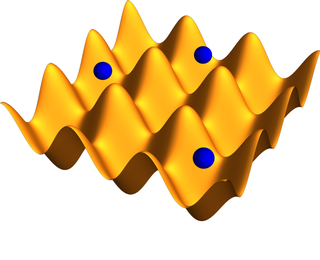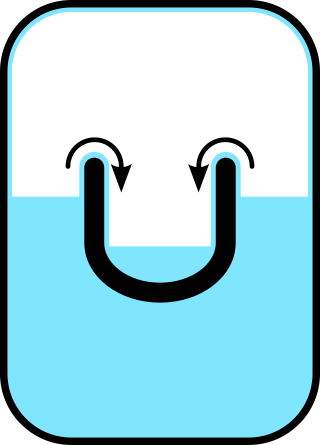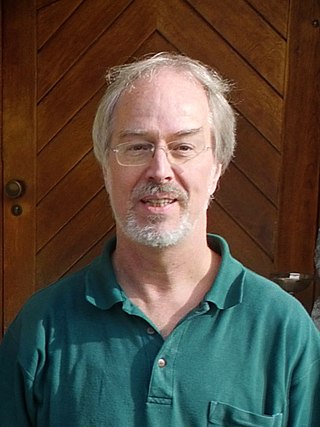
In condensed matter physics, a Bose–Einstein condensate (BEC) is a state of matter that is typically formed when a gas of bosons at very low densities is cooled to temperatures very close to absolute zero. Under such conditions, a large fraction of bosons occupy the lowest quantum state, at which microscopic quantum-mechanical phenomena, particularly wavefunction interference, become apparent macroscopically. More generally, condensation refers to the appearance of macroscopic occupation of one or several states: for example, in BCS theory, a superconductor is a condensate of Cooper pairs. As such, condensation can be associated with phase transition, and the macroscopic occupation of the state is the order parameter.

In condensed matter physics, a supersolid is a spatially ordered material with superfluid properties. In the case of helium-4, it has been conjectured since the 1960s that it might be possible to create a supersolid. Starting from 2017, a definitive proof for the existence of this state was provided by several experiments using atomic Bose–Einstein condensates. The general conditions required for supersolidity to emerge in a certain substance are a topic of ongoing research.

A fermionic condensate is a superfluid phase formed by fermionic particles at low temperatures. It is closely related to the Bose–Einstein condensate, a superfluid phase formed by bosonic atoms under similar conditions. The earliest recognized fermionic condensate described the state of electrons in a superconductor; the physics of other examples including recent work with fermionic atoms is analogous. The first atomic fermionic condensate was created by a team led by Deborah S. Jin using potassium-40 atoms at the University of Colorado Boulder in 2003.
In physics, a Tonks–Girardeau gas is a Bose gas in which the repulsive interactions between bosonic particles confined to one dimension dominate the system's physics. It is named after physicists Marvin D. Girardeau and Lewi Tonks. It is not a Bose–Einstein condensate as it does not demonstrate any of the necessary characteristics, such as off-diagonal long-range order or a unitary two-body correlation function, even in a thermodynamic limit and as such cannot be described by a macroscopically occupied orbital in the Gross–Pitaevskii formulation.

Rudolf Grimm is an experimental physicist from Austria. His work centres on ultracold atoms and quantum gases. He was the first scientist worldwide who, with his team, succeeded in realizing a Bose–Einstein condensation of molecules.
An atom laser is a coherent state of propagating atoms. They are created out of a Bose–Einstein condensate of atoms that are output coupled using various techniques. Much like an optical laser, an atom laser is a coherent beam that behaves like a wave. There has been some argument that the term "atom laser" is misleading. Indeed, "laser" stands for light amplification by stimulated emission of radiation which is not particularly related to the physical object called an atom laser, and perhaps describes more accurately the Bose–Einstein condensate (BEC). The terminology most widely used in the community today is to distinguish between the BEC, typically obtained by evaporation in a conservative trap, from the atom laser itself, which is a propagating atomic wave obtained by extraction from a previously realized BEC. Some ongoing experimental research tries to obtain directly an atom laser from a "hot" beam of atoms without making a trapped BEC first.

An optical lattice is formed by the interference of counter-propagating laser beams, creating a spatially periodic polarization pattern. The resulting periodic potential may trap neutral atoms via the Stark shift. Atoms are cooled and congregate at the potential extrema. The resulting arrangement of trapped atoms resembles a crystal lattice and can be used for quantum simulation.
The Bose–Hubbard model gives a description of the physics of interacting spinless bosons on a lattice. It is closely related to the Hubbard model that originated in solid-state physics as an approximate description of superconducting systems and the motion of electrons between the atoms of a crystalline solid. The model was introduced by Gersch and Knollman in 1963 in the context of granular superconductors. The model rose to prominence in the 1980s after it was found to capture the essence of the superfluid-insulator transition in a way that was much more mathematically tractable than fermionic metal-insulator models.
In condensed matter physics, an ultracold atom is an atom with a temperature near absolute zero. At such temperatures, an atom's quantum-mechanical properties become important.
Atomtronics is an emerging type of computing consisting of matter-wave circuits which coherently guide propagating ultra-cold atoms. The systems typically include components analogous to those found in electronic or optical systems, such as beam splitters and transistors. Applications range from studies of fundamental physics to the development of practical devices.
Markus Greiner is a German physicist and Professor of Physics at Harvard University.

Superfluidity is the characteristic property of a fluid with zero viscosity which therefore flows without any loss of kinetic energy. When stirred, a superfluid forms vortices that continue to rotate indefinitely. Superfluidity occurs in two isotopes of helium when they are liquefied by cooling to cryogenic temperatures. It is also a property of various other exotic states of matter theorized to exist in astrophysics, high-energy physics, and theories of quantum gravity. The theory of superfluidity was developed by Soviet theoretical physicists Lev Landau and Isaak Khalatnikov.
Immanuel Bloch is a German experimental physicist. His research is focused on the investigation of quantum many-body systems using ultracold atomic and molecular quantum gases. Bloch is known for his work on atoms in artificial crystals of light, optical lattices, especially the first realization of a quantum phase transition from a weakly interacting superfluid to a strongly interacting Mott insulating state of matter.

Quantum simulators permit the study of a quantum system in a programmable fashion. In this instance, simulators are special purpose devices designed to provide insight about specific physics problems. Quantum simulators may be contrasted with generally programmable "digital" quantum computers, which would be capable of solving a wider class of quantum problems.
Bose–Einstein condensation can occur in quasiparticles, particles that are effective descriptions of collective excitations in materials. Some have integer spins and can be expected to obey Bose–Einstein statistics like traditional particles. Conditions for condensation of various quasiparticles have been predicted and observed. The topic continues to be an active field of study.

Gerhard Rempe is a German physicist, Director at the Max Planck Institute of Quantum Optics and Honorary Professor at the Technical University of Munich. He has performed pioneering experiments in atomic and molecular physics, quantum optics and quantum information processing.
Bose–Einstein condensation of polaritons is a growing field in semiconductor optics research, which exhibits spontaneous coherence similar to a laser, but through a different mechanism. A continuous transition from polariton condensation to lasing can be made similar to that of the crossover from a Bose–Einstein condensate to a BCS state in the context of Fermi gases. Polariton condensation is sometimes called “lasing without inversion”.
Randall Gardner Hulet is an American physicist.

Monika Aidelsburger is a German quantum physicist, Professor and Group Leader at the Ludwig Maximilian University of Munich. Her research considers quantum simulation and ultra cold atomic gases trapped in optical lattices. In 2021, she was awarded both the Alfried-Krupp-Förderpreis and Klung Wilhelmy Science Award.
Benjamin Leonard Lev is an American physicist and Professor of Physics and Applied Physics at Stanford University. He studies quantum many-body physics, both in and out of equilibrium, by combining the tools of ultracold atomic physics, quantum optics, and condensed matter physics.







